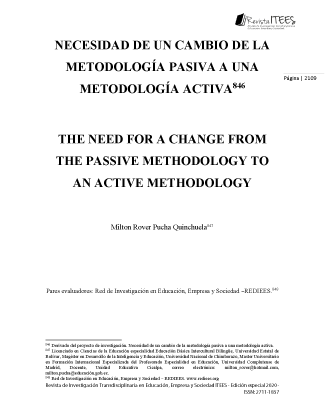CX. NECESIDAD DE UN CAMBIO DE LA METODOLOGÍA PASIVA A UNA METODOLOGÍA ACTIVA
##plugins.themes.bootstrap3.article.main##
Resumen
El presente trabajo describe la práctica docente en el aula, considerando que el profesor es
un actor decidor en la calidad de aprendizajes desarrollados por los y las estudiantes en todos
los niveles. El propósito principal es determinar la metodología utilizada por el docente en el
proceso de enseñanza – aprendizaje, mediante la indagación in situ, para proponer nuevas
metodologías activas que favorezca la construcción de aprendizajes significativos en los
educandos. Este trabajo investigativo se apoyó en la observación directa y sus instrumentos,
en donde evidenció que la mayor parte de docentes utilizan metodología pasiva y tradicional
en sus clases diarias lo que provoca una desmotivación en los y las estudiantes, así como un
mínimo desarrollo de aprendizajes significativos. Como resultado de este trabajo se propone
un manual de metodologías activas, cada una con su respectivo proceso, el mismo que debe
ser socializado mediante talleres, a todo el personal docente, para su posterior utilización en
su práctica de aula, convirtiendo sus clases en espacios activos, participativos, interactivos,
colaborativos, reflexivos y de experiencias significantes. Se puede concluir que, a pesar del
desarrollo y avance de la ciencia y la tecnología, la práctica educativa sigue manteniendo
modelos tradicionales, lo que exige una innovación pedagógica mediante la investigación
permanente por parte del docente a fin de atender las necesidades educativas de los
estudiantes, que cada vez son cambiantes.
Download Statistics
##plugins.themes.bootstrap3.article.details##
metodología activa, enseñanza, aprendizaje, aprendizaje significativo
Amador, Y. (2018). El modelo pedagógico tradicional. ¿Arquetipo de la educación en el
Siglo XXI? Su influencia en la enseñanza de Derecho. Algunas reflexiones sobre el
tema. III Congreso internacional virtual sobre Educación en el Siglo XXI, 791 - 802.
Aula Planeta. (2015). Aula Planeta. Obtenido de Cómo aplicar el aprendizaje basado en
proyectos en diez pasos: https://www.aulaplaneta.com/2015/02/04/recursostic/como-aplicar-el-aprendizaje-basado-en-proyectos-en-diez-pasos/
Castellanos, J., & Alhelí, S. (2018). Aprendizaje colaborativo y fases de construcción
compartida del conocimiento en entornos tecnológicos de comunicación asincrónica.
Innovación educativa, 69 - 88.
Collazos, C., & Mendoza, J. (2006). Cómo aprovechar el "aprendizaje colaborativo" en el
aula. Educación y Educadores, 61 - 76.
Espejo, R., & Sarmiento, R. (2017). Metodologías activas para el aprendizaje. Chile:
Editorial Institucional.
Hernández, C., & Tecpan, S. (2017). Aula invertida mediada por el uso de plataformas
virtuales: un estudio de caso en la formación de profesores de física. Estudios
Pedagígicos XLIII, 193-204.
Kohler Herrera, J. (2005). Importancia de las estrategias de enseñanza y el Plan Curricular.
Liberabit, 25 - 34.
Meza, A. (2014). Estrategias de aprendizaje. Definiciones, clasificaciones e instrumentos de
meición. Propósitos y representaciones, 193 - 213.
Restrepo, B. (2020). Prendizaje basado en problemas. Educación y educadores, 13-15.
Saiz, C., & Fernández, S. (2012). Pensamiento crítico y aprendizaje basado en problemas
cotidianos. REDU, Revista de Diocencia Universitaria, 325 - 346.
Serna, H., & Díaz, A. (2013). Metodologías activas de aprendizaje. Colombia: Fondo
editorial.





